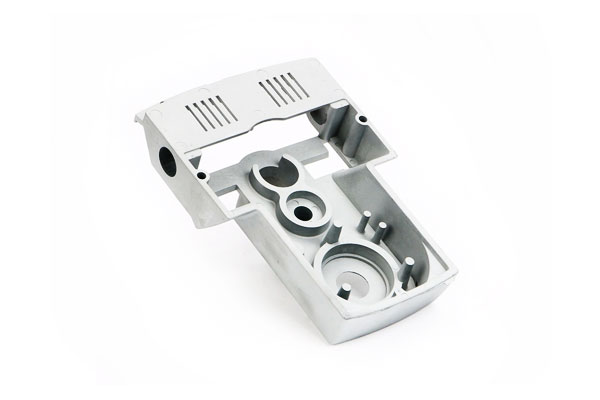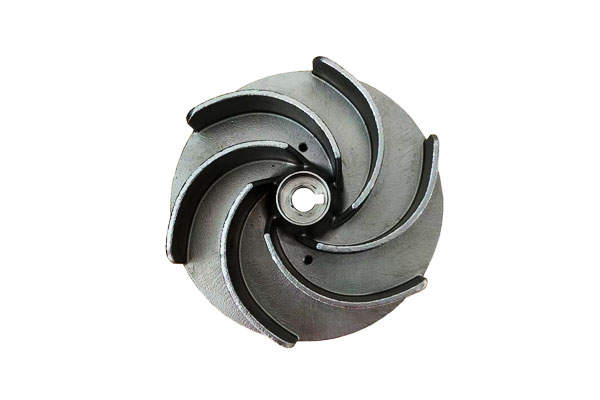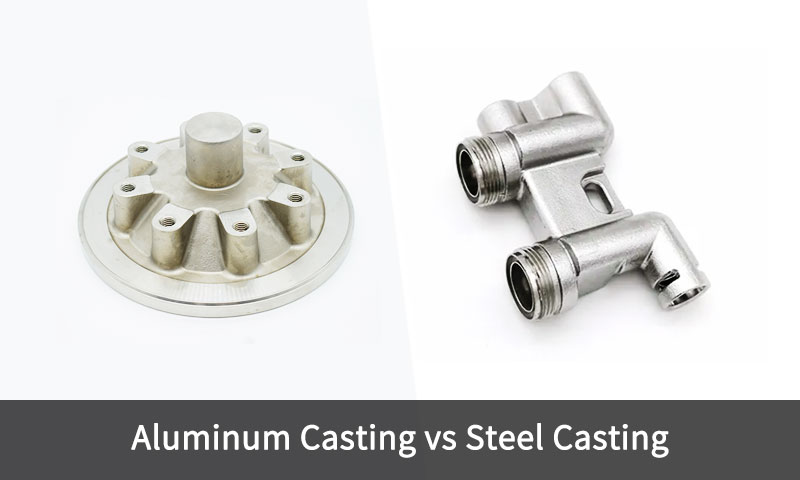1. مقدمه
Aluminum vs Steel Casting — choosing between these two foundational materials shapes component performance, cost and manufacturability across industries from automotive to energy.
This comparison is not merely about metal chemistry: it encompasses density and stiffness, رفتار حرارتی, casting process compatibility, secondary processing (عملیات حرارتی, مهندسی سطحی), lifecycle cost and application-specific reliability.
Engineers and purchasers must therefore evaluate the entire system—loading, درجه حرارت, environment, production volume and finish requirements—before specifying a metal and casting route.
2. Fundamental Material Differences Between Aluminum vs Steel
At the core of aluminum vs. steel casting lies a fundamental metallurgical and physical contrast that directly affects how each material behaves during casting, ماشینکاری, و سرویس.
| دارایی | آلومینیوم (به عنوان مثال, al-i Allays) | فولاد (به عنوان مثال, carbon or low-alloy steels) | پیامدهای مهندسی |
| تراکم (g/cm³) | 2.70 | 7.85 | Aluminum is ~65% lighter, offering major weight savings for transportation and aerospace. |
| نقطه ذوب (درجه سانتیگراد) | 615–660 | 1425–1540 | Aluminum’s low melting point enables easier casting and lower energy consumption; steel requires specialized furnaces. |
| هدایت حرارتی (w/m · k) | 120- 180 | 40-60 | Aluminum dissipates heat efficiently—ideal for engines, مبدلهای حرارتی, و الکترونیک. |
| قدرت خاص (MPa/ρ) | ~100–150 | ~70–90 | Despite lower absolute strength, aluminum’s strength-to-weight ratio surpasses that of steel. |
| مدول الاستیک (معدل) | 70 | 200 | Steel is stiffer, providing better rigidity under load and vibration. |
مقاومت در برابر خوردگی |
عالی (forms Al₂O₃ layer) | متغیر; prone to rust without coatings | Aluminum resists oxidation naturally, while steel needs surface protection (نقاشی, آبکاری, or alloying with Cr/Ni). |
| قابلیت تغییر | عالی | Moderate to difficult | Aluminum’s softness allows easy machining and shorter cycle times; steel requires tougher tooling. |
| بازیافت | >90% recoverable | >90% recoverable | Both materials are highly recyclable, though aluminum’s remelting requires less energy (5% of primary production). |
| Casting Shrinkage (%) | 1.3–1.6 | 2.0–2.6 | Steel shrinks more during solidification, demanding larger allowances and more complex gating/feeding systems. |
| هزینه (تقریبا, دلار/کیلوگرم) | 2.0-3.0 | 0.8–1.5 | Aluminum is more expensive per kilogram, but savings in weight and processing can offset total lifecycle costs. |
3. What Is Aluminum Casting?
آلومینیوم ریخته گری is the process of shaping molten aluminum or aluminum alloys into complex, near-net-shape components using molds.
It is one of the most widely used metal casting processes globally—accounting for over 50% of all nonferrous castings—due to aluminum’s excellent castability, چگالی کم, و مقاومت در برابر خوردگی.

نمای کلی
In aluminum casting, آلومینیوم مذاب (به طور معمول بین 680–750°C) is poured or injected into a mold cavity where it solidifies into the desired geometry.
Aluminum’s low melting point and high fluidity make it ideal for both mass-production methods (like die casting) وت برنامه های با دقت بالا (like investment casting).
Key Features of Aluminum Casting
- نسبت سبک و با استحکام بالا به وزن:
Aluminum castings offer excellent mechanical performance while being about یک سوم وزن فولاد. - مقاومت در برابر خوردگی خوب:
نازک, خود داری aluminum oxide layer (الحس) protects against oxidation and most atmospheric or marine corrosion. - هدایت حرارتی و الکتریکی عالی:
Suitable for applications like مبدلهای حرارتی, محوطه, and electric components. - بازیافت:
Aluminum can be recycled indefinitely without degradation, reducing production energy by up to 95% compared to primary smelting.
Common Aluminum Casting Processes
| روش ریخته گری | توضیحات | برنامه های معمولی |
| دایکستینگ | High-pressure injection of molten aluminum into steel dies; yields precise, قطعات دیواره نازک. | قطعات خودرو (محل تجهیزات دنده, براکت), لوازم الکترونیکی مصرف کننده. |
| ریخته گری | Molten metal poured into sand molds; suitable for larger, lower-volume parts. | بلوک موتور, تنوع, محفظه های هوافضا. |
| ریخته گری سرمایه گذاری | Ceramic molds from wax patterns; ideal for fine details and tight tolerances. | هوافضا اجزای توربین, دستگاه های پزشکی. |
| ریخته گری قالب دائمی | Reusable metal molds; good surface finish and dimensional control. | پیستون, چرخ, و اجزای دریایی. |
| ریخته گری | Uses centrifugal force to distribute molten metal; متراکم, ساختار بدون نقص. | لوله, آستین, and rings. |
مزایای ریخته گری آلومینیوم
- سبک وزن: Reduces component weight by 30-50 ٪ در مقابل. فولاد, improving fuel efficiency (خودرو) or payload capacity (هوا و فضا).
- کارایی انرژی: Melting aluminum requires 60–70% less energy than steel (570° C در مقابل. 1420درجه سانتیگراد), lowering processing costs by 20-30 ٪.
- مقاومت در برابر خوردگی: Eliminates the need for coatings (به عنوان مثال, رنگ, گالوانیزه کننده) در بیشتر محیط ها, reducing maintenance costs by 40-50 ٪.
- High-Volume Viability: Die casting enables production of 1000+ parts/day per machine, meeting consumer goods demand.
Disadvantages of Aluminum Casting
- مقاومت کمتری: استحکام کششی (150-400 MPa) is 50–70% lower than high-strength steel, limiting use in heavy-load applications.
- Poor High-Temperature Performance: Retains only 50% of room-temperature strength at 250°C, making it unsuitable for engine exhaust or power plant components.
- خطر تخلیه: Die-cast aluminum is prone to gas porosity (from high-pressure injection), restricting heat treatment options (به عنوان مثال, T6 temper requires vacuum processing).
- Higher Raw Material Cost: Primary aluminum costs $2,500–$3,500/tonne, 2–3x more than carbon steel.
Industrial Applications of Aluminum Casting
Aluminum casting is widely used across multiple industries due to its combination of طراحی سبک وزن, قابلیت تغییر, و مقاومت در برابر خوردگی:
- خودرو: بلوک موتور, محورهای گیربکس, چرخ, and suspension arms.
- هوافضا: براکت, اتصالات ساختاری, محفظه کمپرسور.
- الکترونیک: غرق شدن, محفظه موتوری, محفظه.
- کالاهای مصرفی: لوازم, ابزارهای قدرت, سخت افزار مبلمان.
- Marine and Renewable Energy: پیشرو, محوطه, و تیغه های توربین.
4. What Is Steel Casting?
Steel casting is the process of pouring molten steel into a mold to produce complex, high-strength components that cannot be easily fabricated or forged.
Unlike aluminum, steel has a نقطه ذوب بالاتر (≈ 1450–1530°C) and greater tensile strength, آن را ایده آل برای load-bearing and high-temperature applications such as machinery, infrastructure, و تولید برق.

نمای کلی
In steel casting, carefully alloyed molten steel is poured into either expendable (ماسه, سرمایه گذاری) or permanent molds, where it solidifies into a shape close to the final part.
Because steel shrinks significantly upon cooling, precise temperature control, دبستان, and solidification modeling بسیار مهم هستند.
Steel castings are known for their استحناء مکانیکی, مقاومت در برابر ضربه, و یکپارچگی ساختاری, particularly under harsh service conditions.
Key Features of Steel Casting
- Exceptional Strength and Toughness:
Yield strengths often exceed 350 MPA, with heat-treated alloys reaching over 1000 MPA. - High-Temperature Capability:
Retains strength and oxidation resistance up to 600–800°C, depending on composition. - Versatile Alloy Selection:
Includes فولاد کربن, فولادهای کم آلیاژ, فولادهای ضد زنگ, and high-manganese steels, each tailored for specific environments. - قابلیت جوشکاری و ماشینکاری:
Cast steels can be post-processed effectively—machined, جوش داده شده, and heat-treated to enhance performance.
Common Steel Casting Processes
| روش ریخته گری | توضیحات | برنامه های معمولی |
| ریخته گری | Molten steel poured into bonded sand molds; ایده آل برای بزرگ, قسمتهای پیچیده. | بدنهای, پمپ, machinery housings. |
| ریخته گری سرمایه گذاری | Ceramic molds formed from wax patterns; yields excellent accuracy and surface finish. | تیغه های توربین, ابزارهای جراحی, قطعات هوافضا. |
| ریخته گری | Rotational force distributes molten steel evenly; produces dense cylindrical components. | لوله, بوش, نژادهای تحمل. |
| ریخته گری قالب | Uses thin resin-coated sand molds; allows higher precision and smoother surfaces. | قطعات موتور کوچک, براکت. |
| ریخته گری مداوم | For semi-finished steel products like slabs and billets. | Raw material for rolling and forging. |
Advantages of Steel Casting
- Superior Strength & سختی: استحکام کششی (تا 1500 MPA) و تأثیرگذاری بر سختی (40–100 J) make it irreplaceable for structural safety (به عنوان مثال, اجزای پل, شاسی خودرو).
- عملکرد درجه حرارت بالا: Operates reliably at 400-600 درجه سانتیگراد (در مقابل. aluminum’s 250°C limit), suitable for jet engine casings and power plant boilers.
- Low Raw Material Cost: Carbon steel costs $800–$1200/tonne, 60–70% less than primary aluminum.
- مقاومت در برابر پوشیدن: Heat-treated steel (به عنوان مثال, 4140) has surface hardness up to 500 HB, reducing replacement frequency in abrasive applications by 50-70 ٪.
Disadvantages of Steel Casting
- High Weight: Density 2.7x that of aluminum increases fuel consumption (خودرو) or structural load (buildings).
- High Energy Use: Melting steel requires 25–30 MWh/tonne (در مقابل. 5–7 MWh/tonne for aluminum), increasing processing costs by 40-50 ٪.
- حساسیت خوردگی: Carbon steel rusts in moist environments (میزان خوردگی: 0.5-1.0 میلی متر در سال in salt spray), requiring coatings (به عنوان مثال, گالوانیزه کننده) that add $1.5–$2.5/kg to costs.
- Poor Machinability: Hardness requires specialized tools, افزایش زمان ماشینکاری توسط 30-50 ٪ در مقابل. الومینیوم.
Industrial Applications of Steel Casting
Steel castings dominate industries demanding قدرت, دوام, و مقاومت در برابر گرما:
- ساخت و ساز & معادن: Excavator teeth, قطعات سنگ شکن, track links.
- انرژی & نیروگاه: Steam turbine casings, بدنهای, اجزای هسته ای.
- روغن & گاز: Drill heads, pipeline valves, تنوع.
- حمل: Train couplers, محل تجهیزات دنده, heavy-duty engine blocks.
- هوافضا & دفاع: دنده, اتصالات ساختاری, armor components.
5. مقایسه جامع: آلومینیوم در مقابل ریخته گری فولاد
Process fit and part geometry
- دارای دیوار نازک, مجتمع, قطعات با حجم بالا: aluminum die casting is optimal (HPDC).
- بزرگ, سنگین, load-bearing parts: steel/spheroidal graphite (دوک) iron and cast steels via sand casting are preferred.
- Medium volume with high integrity requirements: low-pressure aluminum or investment casting steels depending on strength needs.
Mechanical performance & پس از فرآیند
- عملیات حرارتی: cast steel can be quenched & tempered to obtain high strength and toughness; aluminum alloys have age-hardening routes but reach lower maximum strengths.
- Surface engineering: aluminum readily anodizes; steel can be nitrided, carburized, induction hardened or coated with hard substances (سرامیک, کروم سخت).
رانندگان هزینه (typical considerations)
- Material cost per kg: aluminum raw metal tends to be priced higher per kg than ferrous scrap/steel, but part mass reduces required amount.
- ابزار: die casting dies are expensive (high initial amortization) but low per-part cost at volumes >10k–100k; sand tooling is cheap but per-part labor higher.
- ماشینکاری: aluminum machines faster (higher removal rates), lower tool wear; steel requires harder tooling and more machining time—raises total cost especially for small batches.
تولید & defect modes
- تخلخل: HPDC aluminum can develop gas and shrinkage porosity; permanent-mold and low-pressure reduce porosity.
Steel castings can suffer inclusions and segregation; controlled melting and post-HT reduce defects. - کنترل ابعادی: die cast aluminum attains tight tolerances (0.1-0.3 میلی متر); sand cast steel tolerances are looser (±0.5–2 mm) without post-machining.
زیست محیطی & life-cycle
- بازیافت: both metals are highly recyclable. Recycled aluminum uses a small fraction (~5–10%) of the energy of primary smelting; recycled steel also has large energy savings compared to virgin iron.
- Use-phase: lightweight aluminum can reduce fuel consumption in vehicles — a system-level environmental benefit.
جدول: Aluminum vs Steel Casting — Key Technical Comparison
| دسته | ریخته گری | ریخته گری |
| تراکم (g/cm³) | ~2.70 | ~7.80 |
| نقطه ذوب (درجه سانتیگراد / ° F) | 660درجه سانتیگراد / 1220° F | 1450–1530°C / 2640–2790°F |
| قدرت (کشنده / بازده, MPA) | 130-350 / 70–250 (دارای بازار بی نظیر); تا 500 بعد از عملیات حرارتی | 400–1200 / 250–1000 (بسته به درجه و عملیات حرارتی) |
| سختی (HB) | 30–120 | 120-400 |
| مدول الاستیک (معدل) | 70 | 200 |
| هدایت حرارتی (w/m · k) | 150–230 | 25-60 |
| هدایت الکتریکی (% قید) | 35-60 | 3–10 |
| مقاومت در برابر خوردگی | عالی (لایه اکسید طبیعی) | Variable — requires alloying (کلوچه, در, مس) یا روکش |
| مقاومت در برابر اکسیداسیون (High-Temp) | محدود (<250درجه سانتیگراد) | خوب به عالی (up to 800°C for some alloys) |
| قابلیت تغییر | عالی (نرم, easy to cut) | متوسط تا فقیر (سخت تر, ساینده) |
| قابلیت استفاده (سیالیت & انقباض) | سیالیت بالا, انقباض کم | Lower fluidity, higher shrinkage — needs precise gating |
| مزیت وزن | ~65% lighter than steel | Heavy — suitable for structural loads |
پایان سطح |
صاف, good detail reproduction | Rougher surfaces; may need machining or shot blasting |
| Heat Treatment Flexibility | عالی (t6, T7 tempers) | گسترده (بازپخت, فروکش, خویشاوند, عادی سازی) |
| بازیافت | >90% recycled efficiently | >90% recyclable but requires higher remelting energy |
| Production Cost | Lower energy, زمان چرخه سریعتر | Higher melting cost and tool wear |
| تحمل های معمولی (میلی متر) | ±0.25 to ±0.5 (ریخته گری); ±1.0 (ریخته گری) | ±0.5–1.5 depending on process |
| Environmental Footprint | کم (especially recycled aluminum) | Higher CO₂ and energy footprint due to high melting point |
| برنامه های معمولی | چرخ های خودرو, محوطه, قطعات هوافضا, کالاهای مصرفی | دریچه, توربین, ماشین آلات سنگین, مؤلفه های ساختاری |
6. پایان
Aluminum and steel castings solve different engineering problems.
Aluminum excels where وزن سبک, هدایت حرارتی, surface quality and high production rates matter.
فولاد (and cast irons) dominate where استحکام بالا, سفتی, مقاومت در برابر پوشیدن, toughness and elevated temperature performance لازم هستند.
Good material selection balances functional requirements, هزینه (total life cycle), producibility and finishing.
In many modern designs hybrid solutions appear (steel inserts in aluminum castings, clad or bimetallic components) to exploit the strengths of both metals.
متداول
که قوی تر است: cast aluminum or cast steel?
Cast steel is significantly stronger—A216 WCB steel has a tensile strength of 485 MPA, 67% higher than A356-T6 aluminum (290 MPA).
Steel also has far greater toughness and wear resistance.
Can cast aluminum replace cast steel?
Only in applications where weight reduction is prioritized over strength (به عنوان مثال, automotive non-structural parts).
Steel is irreplaceable for high-load, high-temperature components (به عنوان مثال, توربین).
Which is more corrosion-resistant: cast aluminum or cast steel?
Cast aluminum is more corrosion-resistant in most environments (میزان خوردگی <0.1 MM/سال) در مقابل. فولاد (0.5-1.0 میلی متر در سال).
Stainless steel castings match aluminum’s corrosion resistance but cost 2–3x more.
Which casting process is best for aluminum vs. فولاد?
Aluminum is ideal for die casting (با حجم زیاد) and sand casting (کم هزینه).
Steel is best for sand casting (قسمتهای بزرگ) و ریخته گری سرمایه گذاری (مجتمع, high-tolerance components). Die casting is rarely used for steel.


